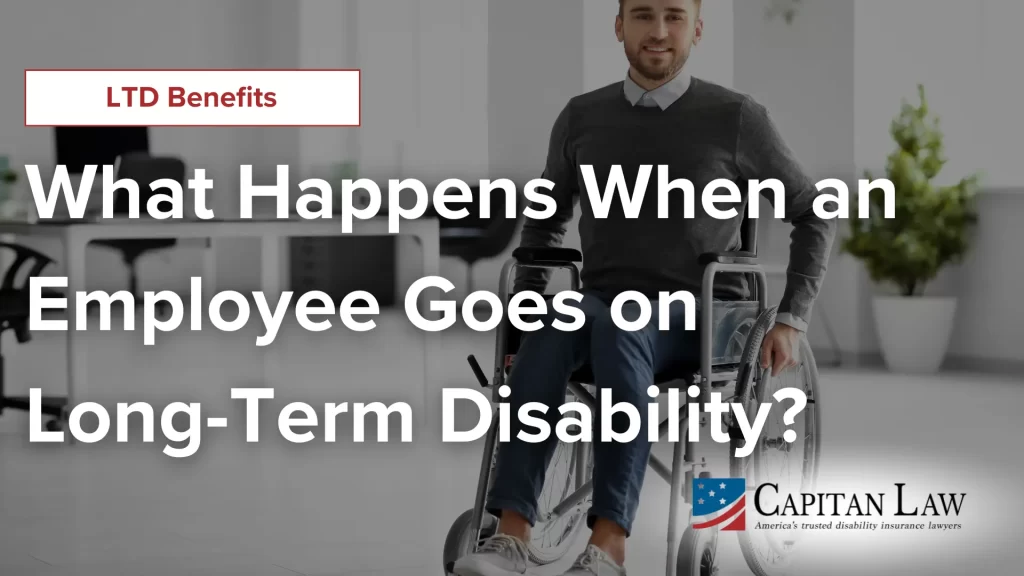Posted on Sunday, May 12th, 2024 at 6:12 pm

If you’re dealing with a serious medical condition that prevents you from working, you may need to file a claim for long-term disability (LTD) benefits. These benefits can provide a percentage of your income while you cannot work. But what happens when an employee goes on long-term disability? How does the LTD process work, and what should you expect?
Applying for Long Term Disability Benefits
The first step in applying for long-term disability is filing a claim with your LTD insurance carrier. You can find the necessary forms on your insurer’s website or request them from your employer’s HR department.
To file an LTD claim, you’ll need to gather medical evidence of your disabling condition, including treatment notes from your physicians, diagnostic test results, and a written statement from your doctor explaining your condition and why you can’t work. You’ll also need to provide information about your specific job duties.
Additionally, you may need to satisfy an elimination period before your LTD benefits kick in. The elimination period is like a waiting period, typically lasting 90 or 180 days. You may be able to use paid time off or receive short-term disability benefits if your employer offers that coverage.
Once your claim is submitted, the LTD insurance company will review the evidence and either approve or deny your claim. If approved, you’ll start receiving monthly LTD benefit payments. If denied, you’ll have the right to appeal that decision. Understanding what happens when an employee goes on long-term disability can help you navigate this process more effectively.
Your Employment Rights While on Long-Term Disability
After you leave on a long-term disability, you may be worried about your employment status. What happens when an employee goes on long-term disability? Can you be terminated while on long-term disability? The answer depends on several factors.
First, if you qualify for leave under the Family and Medical Leave Act (FMLA), your employer must hold your job open for up to 12 weeks. However, FMLA leave is unpaid and runs concurrently with any paid leave you take, such as using vacation days. Once you exhaust your 12 weeks of FMLA, your job is only protected if you have an employment contract stating so.
If you don’t qualify for FMLA or you’ve already exhausted your 12 weeks, your employer can technically terminate your employment unless your contract forbids it. However, you can still retain your LTD benefits.
Some employees have concerns that their employer will fire them and then try to terminate their LTD coverage. However, your employer can only cancel your LTD policy when you are working. If you’re off work because of your disability, you have the right to continue your LTD coverage, although you may have to start paying the premiums yourself to keep the policy in force.
Returning to Work After Long-Term Disability
If your medical condition improves and you can return to work full-time or part-time, notify your LTD insurer immediately. Depending on the terms of your policy, you can continue receiving partial benefits for some time while you transition back to work.
Your LTD policy may include vocational rehabilitation benefits to help you return to the workforce. These benefits may include job training, career counseling, resume assistance, and job placement services.
Under the Americans with Disabilities Act (ADA), your employer must make reasonable accommodations to help you return to work after a disability. Reasonable accommodations may include modifying your work schedule and job duties or providing special equipment.
If you cannot return to your previous job, you may need to look for other positions that fit your skills and limitations. Your LTD insurer may offer assistance with this process. However, remember that you’ll only continue receiving LTD benefits if you cannot work. Your LTD benefits will likely end if you find another job, even at a lower pay rate.
How Long Can an Employee Be on Long-Term Disability?
 The maximum time you can receive LTD benefits depends on your insurance policy. Most employer-sponsored LTD plans have a maximum benefit period until age 65 or the Social Security retirement age. However, some policies may specify a maximum benefit period.
The maximum time you can receive LTD benefits depends on your insurance policy. Most employer-sponsored LTD plans have a maximum benefit period until age 65 or the Social Security retirement age. However, some policies may specify a maximum benefit period.
Carefully reviewing your LTD policy is essential to understanding how long your long-term disability benefits may last. You should also be aware that most LTD policies have two different definitions of disability that apply after your initial term of benefit— usually two years.
With many LTD policies, during the first two years of LTD, you’ll qualify for benefits if you cannot perform your occupation. After two years, most policies switch to an “any occupation” definition of disability. You’ll only continue receiving benefits if you cannot work in any job you’re reasonably qualified for based on your education, training, and experience.
Get Help Understanding Long Term Disability
Going on long-term disability can be a stressful and confusing experience, especially if you’re dealing with a denied LTD claim. The legal team at Capitan Law focuses exclusively on disability insurance claims. We help employees fight for the benefits they’re entitled to under their LTD policies.
If you’re considering filing for long-term disability or your claim has been wrongfully denied, contact us online or call (267) 419-7888 for a free consultation with one of our Philadelphia long-term disability attorneys. We’ll review your case and explain your legal rights and options at no cost. Call us today for the answers to long-term disability claims and appeals.
Related Posts:
Who Pays Health Insurance While on Long-Term Disability?
Long Term Disability Appeal Letter Sample & Guide
Can You Collect Long-term Disability and Social Security at the Same Time?